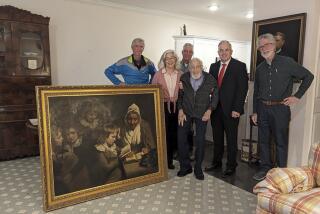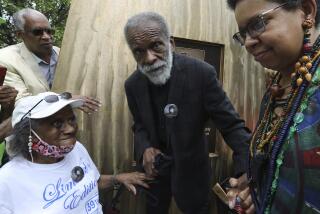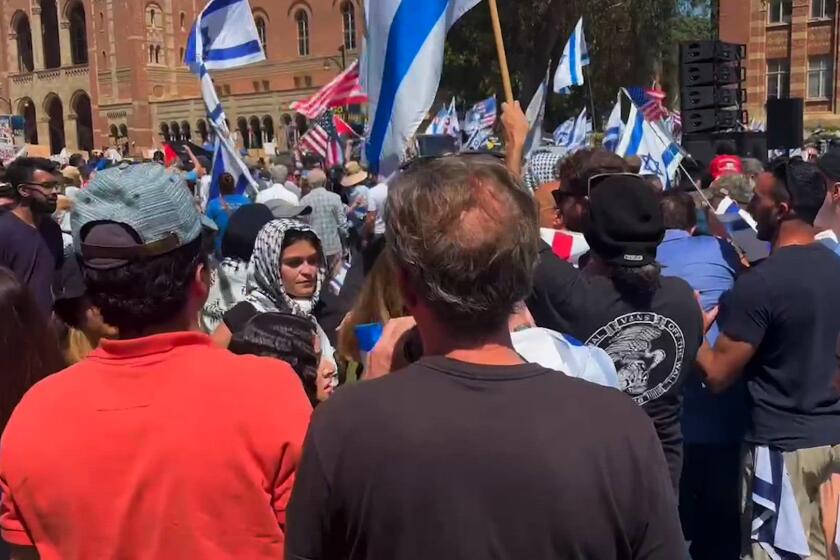Selling the dream
I’m not an intellectual. (A friend has removed most of the “ain’ts” and cuss words from this article.) I know something about art, but I’m not powerful or rich. I’m an old man now, tired and with some health issues. So it sometimes amuses me that whenever an African American cultural institution is under attack in this city, folks start phoning me like I’m the hero of “Shaft,” as if I could fly out the door and take care of it.
What’s got everyone so upset this time is the news that one of the black community’s most admired businesses, the 82-year-old Golden State Mutual Life Insurance Co., has put up for auction 94 of the works in its important and beloved collection of African American art. Among those on the block this Thursday in New York: sculptures by Elizabeth Catlett, a print by famed painter Jacob Lawrence and drawings by the father of Afro-American art, Charles White. Each one is a priceless work by an acknowledged American master.
The whole idea of the sale has put a knot in my stomach. Golden State Mutual has struggled in recent years, and auctioning this treasure -- for maybe as much as $2 million (chicken feed in the white art world, by the way) -- may provide capital it needs. If it’s true, the thought of Golden State Mutual holding out its hand for pennies is almost equally painful.
When I was a boy, in the 1930s and ‘40s, Golden State Mutual and its proud agents literally did hold out their hands for pennies. In those days, blacks could, if they were lucky, buy burial insurance from white companies, but that was all. White folks were ready to plant us but not protect us. All that changed when Golden State Mutual came along. Black mothers, like my own, saved their pennies for life insurance policies that initially cost less than my shoes. Golden State Mutual grew into the largest black-owned insurance company west of the Mississippi.
The Golden State Mutual insurance man, in his rumpled seersucker suit and little briefcase, was a symbol of the entrepreneurial spirit of the black community. In 1949 (one year after I graduated from Jordan High School in Watts and took my first job as a janitor at the County Museum in Exposition Park), Golden State Mutual finally had enough capital, on the strength of all those mothers’ pennies, to expand its business from a one-room office on Central Avenue into a five-story building on the corner of Western and Adams boulevards designed by the renowned black architect, Paul R. Williams. Its three founders -- George A. Beavers, Norman O. Houston and William Nickerson Jr. -- understood that the black community and its capital had made them, and they wanted to give something back.
They commissioned two dynamite artists from the Harlem Renaissance -- Charles Alston and Hale Woodruff -- to create two murals for the lobby of the new building. Under the joint title “The Negro in California History,” they together tell the history of black people’s struggles and achievements. Also in the lobby were bronze sculptures of the founders, commissioned from another Harlem Renaissance master, Richmond Barthé. The selection of artists like this to engage big themes like this made a hell of a statement.
In July 1965, 40 years after it was founded, the company dedicated the new “Golden State Mutual Afro-American Art Collection”; it was, in effect, those founding men’s gift to the black community in Los Angeles. They hired local watercolorist William Pajaud to curate and build the collection. Because black artists had bought into the company’s inspirational, socially-conscious vision, Pajaud was able to purchase works at a fraction of their market value. With his tiny budget of $5,000 a year, he amassed a collection that is -- by any historical or cultural standard, but certainly by aesthetic ones -- priceless. It includes pieces by muralist John Biggers, sculptor Edmonia Lewis and assemblage artist (and Watts Towers director) John Outterbridge as well as early works from Betye Saar’s 50-year career. It also includes works by L.A.’s young masters, artists I am proud to have mentored, such as Varnette Honeywood, Noni Olabisi, Willie Middlebrook and Richard Wyatt Jr.
By the way, when Wyatt -- one of the city’s great muralists -- was very young, he did a mural for the Golden State Mutual collection called “The Insurance Man.” He gave the agent in that painting the rumpled look and briefcase that I remember seeing at my mother’s door in Watts in the 1940s. We knew then that the Golden State Mutual insurance man was special; he was doing something for our community, helping us live and die in dignity. That’s a legacy that no one but a fool would want to sell off.
So, respectfully, I have a few questions for the man responsible for this sale, Larkin Teasley, Golden State Mutual’s president and CEO. Is this auction only about money? If so, what does that say about your stewardship of one of our city’s proudest financial institutions? I’m no tax lawyer, but don’t you businessmen learn in Bookkeeping 101 how to donate important assets, like this collection, for fat tax write-offs? Did you consult anyone from the Los Angeles art community before you decided to sell away our heritage? Did you leak the news to any of the important collectors here -- the Los Angeles County Museum of Art, the Museum of Contemporary Art, Eli Broad, Leon Banks, the Cosbys -- to see if any of them could help keep the collection intact and in town?
And finally, what do you think your predecessors, the ones enshrined in bronze in the lobby, would have to say about selling off the collection they used their lives and reputations to create?
These are just the questions of an old man, an art lover and a onetime fan of yours, Mr. CEO. I ain’t no John Shaft, but I am still a die-hard advocate for L.A.’s black community. It took me most of 50 years to rise from a janitor to a curator working in modern art at LACMA. In that time, I learned to make the concerns of African American art, artists and history my life -- just like those insurance agents of my youth made selling policies to those black mothers the main event in their own.
Forgive me, Mr. CEO, but the very idea of selling off even part of this collection seems to me like a betrayal of the dream of those three great men who built Golden State Mutual on pennies from mothers like mine, and probably yours too.
Cecil Fergerson retired from LACMA in 1985. He was designated an L.A. Living Cultural Treasure in 1998.
More to Read
Start your day right
Sign up for Essential California for news, features and recommendations from the L.A. Times and beyond in your inbox six days a week.
You may occasionally receive promotional content from the Los Angeles Times.






